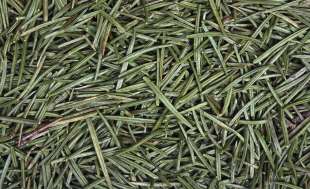
Posted on August 10, 2016 in Landscaping Tips, Organic Gardening,
When it comes time to decide on what type of landscape material to install in your flower beds, pine needles deserve attention. Using pine needles (a.k.a. pine straw), in flower beds is a healthier, cheaper and less labor intense option. You’ll reap year round benefits with a long lasting, rustic brown color. Landscaping with pine needles is also a fun experience with the family as well.

Landscaping with pine needles in flower beds is super beneficial. Pine needles will lock in moisture for your plants and vegetables maximizing the health and strength of root systems. The amount of pests attracted to pine needles is far less than other options such as mulch or pine bark.
Pine needles go overlooked when it’s time to decide on which landscape material to install in flower beds or vegetable gardens. Maybe it’s the fact that most landscaping nurseries or landscape supply stores don’t usually carry them, or maybe it’s because people prefer a loose product or a bundled product? Whatever the reasoning, devote your attention to pine needles.
Most of the time with mulch and pine bark products, there will be a nice 4-6 month period where the colors will be bright and vibrant. The mulch and pine bark can only handle the scorching sun for so long before the colors fade and a weary gray color begins to settle in. Pine straw can last several years before needing to be replaced. If you want to keep it vibrant, you can simply apply a thin layer on top to spruce it up once a year.
Another strong benefit pine straw: its ability to block out weeds. No matter what you ultimately choose to use as your landscape material, you’ll always fight with weeds, but with pine straw, you’ll save yourself some time. The deeper you install the beds, the more light they’ll block out, containing the weeds further. The same can be said for mulch and pine bark. However, pine needles will not blow away with a strong wind or float away with a heavy downpour. Pine straw stays compact and will not move, making it a great option for hills and slopes as well.
After you factor in all the performance upgrades pine needles provide, it’s time to evaluate the economic and financial impacts. Most products such as mulch, pine bark or rubber mulch contain dyes and are not harvested naturally exhausting earth’s resources.
Using pine needles is as natural as it gets. They fall off of the tree limbs vs. mulch or pine bark which is shaven off the sides of trees that have been cut down in the forest to be used for lumber or numerous other purposes. Rubber mulch brings the worst economic impact to the table, so let’s not go there.
Switching to pine straw is just another way to create a beautiful landscape while lending a helping hand to Mother Nature.
Beyond what positive economic impact pine needles provide, there’s another impact, financial. To cover a 10’ x 10’ area at 2.5” – 3” depth, you’ll need approximately 11 2.5 cubic ft bags of either mulch or pine bark at about $2.50 per bag. Using pine needles, you need only two bales at $5 – $7 per bale. Per a 1,000 sq ft area, that’s a cost of $275 plus tax for mulch and pine bark vs. $100-$140 for pine needles. That adds up!
In sum, using pine straw instead of mulch will reduce the cost of your landscaping project, and give flower beds longevity, while providing positive economic impacts. For all of these reasons, landscaping with pine needles should be your go-to choice. There are many different ways to to incorporate pine needles into your landscape environment. Not matter how you decide to incorporate them, know that you’re making a difference and that is what counts more than anything.
If you have questions or would like to see if we are in you service area, we’re always here to help in anyway.

This company is the absolute best! Great staff knowledgeable of their work . Super professional!
- Faith Lugo
5 years ago